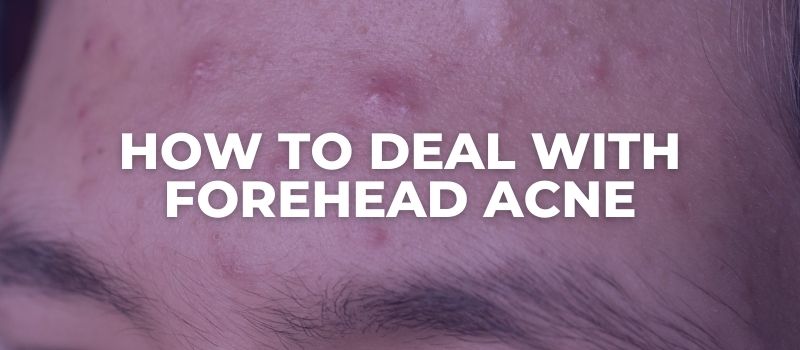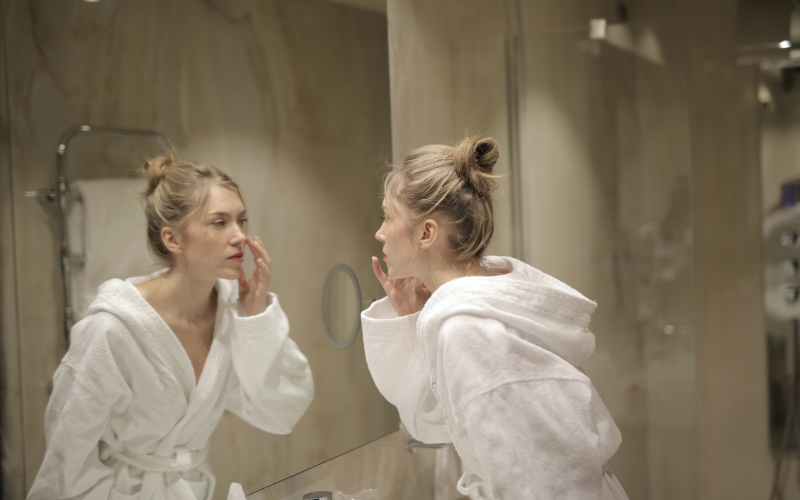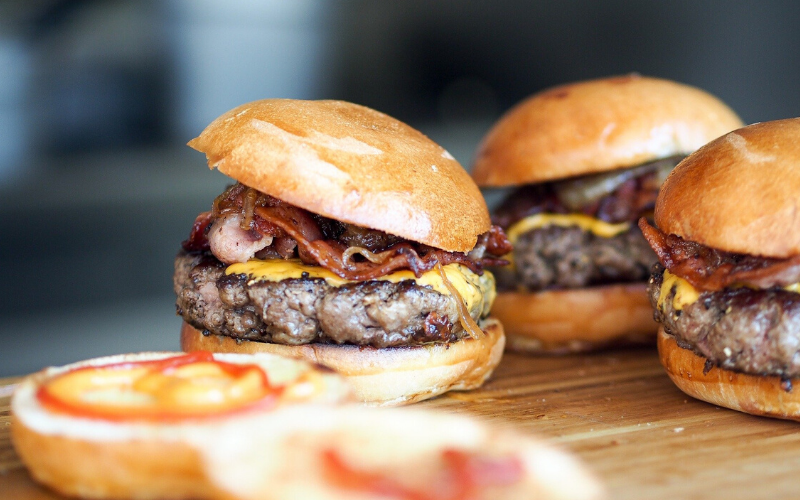Forehead acne is a common occurrence that typically manifests itself in the form of solid red bumps that often have a collection of pus at the top, but this doesn’t always have to be the case.
To get rid of forehead acne, you should start with good skincare and you should pay special attention to exfoliation as this is the best solution for many skin concerns.
Additionally, if that alone doesn’t work for you, you can try over-the-counter acne treatments that contain ingredients (like benzoyl peroxide).
In this article, I will share 4 skincare ingredients you can use to get rid of forehead acne.

The 4 Ingredients You Need To Get Rid Of Forehead Acne
There are many excellent products on today’s market that can efficiently target clogged pores and work to exfoliate, get rid of excess oil, as well as soothe inflamed areas and get rid of forehead acne.
Some of the best forehead acne treatments include:
- benzoyl peroxide,
- salicylic acid,
- glycolic acid, and
- azelaic acid.
Benzoyl Peroxide
Benzoyl Peroxide is an ingredient that’s proven to have an antibacterial effect that specifically inhibits and destroys the acne-causing bacteria P. acnes that live deep in your pores and survive on your natural oil, dead skin cells, and skin tissue.
It can be quite drying for the skin if not used properly and this is why many people experience side effects that include sensitive skin, burning sensation, redness, peeling, and inflammation.
However, there are many ways you can go wrong using benzoyl peroxide but if used properly, it can successfully heal your acne without having any adverse effects on the skin.
Be sure to read my article on how to safely use benzoyl peroxide to get rid of acne.
Salicylic Acid
Salicylic Acid is one of the mildest and most effective acne-treating ingredients you can possibly find.
Salicylic acid works by mimicking the natural exfoliation process of younger skin by helping it shed extra layers of dead skin cells at a quicker rate than normal.
This means that you have less dead skin cells on the skin’s surface that can potentially clog your pores and lead to unwanted acne breakouts.
Additionally, salicylic acid is an oil-soluble ingredient, which means it can cut through the surface oil to get inside the pores and remove the buildup of sebum, bacteria, dead skin cells, and white blood cells.
Furthermore, it is a very gentle, anti-inflammatory ingredient that is easily tolerated by the skin and it takes very little time getting used to.
Read my comparison review between the two most popular salicylic acid products on the market.
Glycolic Acid
Glycolic acid is an alpha-hydroxy acid and a naturally occurring substance found in sugar cane that has the smallest molecule size, which makes it perfect to be easily absorbed by the skin and enter the ducts, pores, and follicles.
Glycolic acid is a water-soluble acid that loosens the bonds between the dead skin cells and peels them away to provide good exfoliation of the upper skin layer with minimal irritation.
It is mostly useful to treat scarring, discoloration, spots or patches of pigmentation, premature fine lines, and wrinkles, however, it can also have a profound effect on mild acne breakouts such as the ones on the forehead as well as bumpy skin texture.
You can read my guide on glycolic acid here.
Azelaic Acid
Azelaic Acid is an ingredient that wasn’t well-known in the skincare industry until some time ago. However, research has shown that this ingredient can have a significant positive impact on the skin and certain skin concerns.
Azelaic acid can diminish the appearance of skin blemishes, help fade post-acne redness, pigmentation, and other discoloration, refine the skin’s surface, and reveal a brighter and more even complexion among other actions.
The reason why it suddenly became loved and respected by everyone is that azelaic acid is not an irritating ingredient and is fairly tolerable by all skin types, including sensitive and compromised skins.
Read my comparison review between the two most popular Azelaic acid products on the market.
Besides using skincare products to minimize forehead acne, you can also resort to implementing some totally free habits, including:
- not picking your acne.
- avoid wearing headbands, hats, and other clothing materials that can potentially allow bacteria to spread.
- avoid using oils and heavy, suffocating creams.
- avoid using too much makeup on the affected area.
- washing your makeup brushes to prevent bacteria from spreading.
What Causes Pimples On The Forehead?

People can develop forehead acne and pimples when the pores on the skin become clogged with excess oil, dead skin cells, and white blood cells. Hormonal changes, stress, poor hygiene, bad skincare products, etc, can be common triggers for developing forehead acne.
Let’s address several of these below:
Using bad skincare products
Skincare products can help you address many skin concerns and these days we have products specially formulated for all skin types.
However, that doesn’t mean that all skincare products are good and companies out there produce flat out bad skincare products.
Many skincare products contain heavy and pore-clogging ingredients that can worsen those pesky little bumps across your forehead and also contribute to acne starting to appear in other areas, too.
Additional to that, there are also products containing ingredients that are too harsh and have the potential to damage your skin barrier so using them might harm the skin’s moisture-holding capacity.
Some of these are drying alcohols such as Alcohol denat as well as fragrance and other fragrant components that can awfully irritate and dehydrate the skin.
When this happens, the skin can become sensitized and dehydrated, which will inevitably trigger the sebaceous glands into overproducing oil which can then clog the pores and cause more acne.
Unfortunately, many of these ingredients are advertised as moisturizing, softening, hydrating, etc.
However, this tells us that we should never trust the claims written on the package but we should always check the ingredients at the back of the product as this will help us make an informed decision.
Hormones can sometimes cause forehead acne
Hormones can often be blamed for triggering acne breakouts and this is almost always the case when it comes to puberty, pregnancy, as well as occasional pimples you get during your period.
Additionally, hormones released during stressful situations can also stimulate the sebaceous glands to produce more oil, leading to more clogging and acne breakouts.
And while this may sound like something you cannot control, you definitely can and I am going to teach you how to combat acne caused by hormones with nothing but good skincare and a little bit of self-love.
Hair and hair products can cause forehead acne
Your hair can also be a potential culprit for having forehead acne.
If you naturally have oily hair or you don’t wash your hair often enough, the oil can easily deposit on your forehead and clog the pores on your skin.
Hairstyling products are also notorious for causing acne and some of these may include hair straightening products as well as pomades, oils, gels, waxes, etc.
These products often contain heavy and potentially clogging ingredients like castor oil, argan oil, cocoa butter, coconut oil, etc, that can leave your hair and also your skin extra oily.
Moreover, from personal experience, I remember having little pustular bumps on my forehead when I used to have a fringe because my hair was always sitting on my skin and was constantly getting greasy as hell.
So, perhaps moving your hair to the side and keeping it away from your skin may result in less forehead acne.
Hats, beanies, clothing, and makeup can cause forehead acne
Constantly wearing hats, beanies, headbands, etc, may cause irritation on your skin that can result in acne.
Especially if you like to hit the gym every so often but forget to wash your cap or headband regularly, this may contribute to sweating and bacteria spreading that will essentially result in acne.
Additionally, foundations are also notorious for causing acne, especially if they contain clogging ingredients contributing to that buttery, full-coverage effect.
On the other hand, mattifying foundations that often contain Alcohol denat to dry out the skin and give that much desired matte effect can trigger the sebaceous glands to produce more pore-clogging oil to compensate for the lack of hydration.
What Foods Cause Forehead Acne?

Processed foods such as sweets can rapidly raise your blood sugar and contribute to excess production of the hormone insulin which can cause forehead acne.
A sugar rush makes your body work hard to get back to normal levels and this roller coaster of ups and downs can leave you feeling nervous, foggy, irritable, drained, and stressed.
Moreover, having a diet rich in calories, fat, and refined carbohydrates such as burgers, nuggets, fries, etc., can cause forehead acne due to the potential hormone-altering effect.
This, however, isn’t scientifically proven, though it is important to note that most of the research on the connection between fast food and acne has used self-reported data.
Having forehead acne may be a mild skin concern but that doesn’t mean it should be neglected and ignored as this has the potential to spread and become worse over time.
While it may seem that there is nothing you can do about it, there are plenty of habits you can implement to stop the acne bacteria from spreading as well as many products that you can use to treat and heal acne flare-ups on the forehead.

My name is Simone and I am a certified skin specialist. I created this website to teach my readers how to take great care of their skin and I also like to occasionally share my honest opinions on skincare products I’ve tried. You can learn more about me here.
